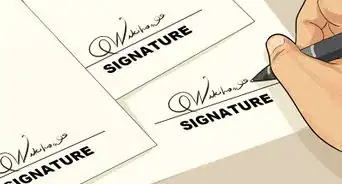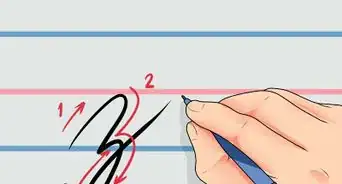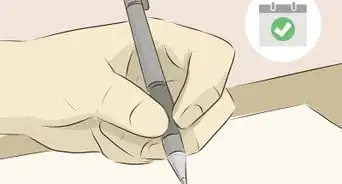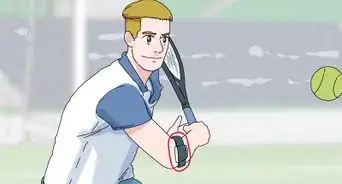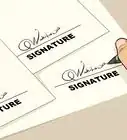This article was co-authored by Joel Giffin, PT, DPT, CHT. Dr. Joel Giffin is a Doctor of Physical Therapy and the Founder of Flex Physical Therapy in New York, New York. With over 15 years of experience as a Certified Hand Therapist (CHT), Dr. Giffin treats the whole body and specializes in rehabilitation of the hand and upper extremities. He has treated Broadway theater performers backstage at shows such as The Lion King, Sleep No More, Tarzan, and Sister Act. Flex Physical Therapy also specializes in occupational and pelvic floor therapy. Dr. Giffin earned his Master’s degree in Physical Therapy with honors from Quinnipiac University and received his Doctor of Physical Therapy (DPT) degree with distinction from Simmons College. He is a member of the American Physical Therapy Association and the American Society of Hand Therapists.
wikiHow marks an article as reader-approved once it receives enough positive feedback. This article received 59 testimonials and 100% of readers who voted found it helpful, earning it our reader-approved status.
This article has been viewed 1,375,072 times.
Have you always wanted to be a leftie? Even if you're naturally right-handed, you can actually learn to write with your left hand, and we'll show you how! Try the tips below, and soon you'll be writing left-handed no problem.
Steps
Writing Practice
-
1Understand the complexities of writing with your left hand. Understand that to control your non-dominant hand, your brain will have to form new neural connections.[1]
- This is not a fast or easy process, so you will need to be prepared to put in many hours of practice if you plan on becoming ambidextrous.
- Developing these motor skills will probably give you a whole new appreciation of what babies’ lives are like.
-
2Start slow. Begin printing the alphabet in both capital and lowercase letters, then move on to sentences. When printing becomes comfortable, you can start practicing your cursive.
- If your writing is very messy in the beginning, start by tracing large text out of a book or magazine. It may also help to buy children’s paper, which has widely spaced lines for large printing and dotted center lines to control the letter proportions.
- Another good thing to do is to observe the way left-handers write or just ask them for some tips.
Advertisement -
3Practice writing every letter. Write "The quick brown fox jumps over the lazy dog" or "Pack my box with five dozen liquor jugs" or even "The five boxing wizards jump quickly" over and over to improve left-hand neatness. These sentences are good because they use every single letter in the English alphabet.
- You should also practice writing the most common words in your language and your name, as this will teach your muscles common letter combinations. Lists of the most common words in each language can be found on Wikipedia.
- Be prepared for the fact that your left arm and hand muscles will be quite sore after writing practice. This is because you are training certain muscles for the very first time.
-
4Draw basic shapes. Drawing basic shapes will help to strengthen your left hand and give you more control over the pen or pencil.
- Stick people, square houses with rectangular chimneys, round-headed cats with triangular ears…the goal here is to become more dexterous, not to produce a Rembrandt.
- Try coloring them in as well to make you feel more comfortable with your left hand.
- Also, try to draw straight lines from left to right using your left hand. It will teach you to push, not pull.
-
5Learn mirror script. For left-handers, it is easier to pull the pen to the left than to push it to the right. Therefore, writing backward with your left hand is easier than writing forwards.[2]
- You can just write backward (from right to left) or you can practice mirror script, where the letters themselves have flipped around.
- Writing backward is also helpful because you will not smear the ink or tear the page when you write with a pen—however, it will not be that easy for others to read, so try to save it for your diary (just like Leonardo da Vinci!)
-
6Use the right kind of pens. Liquid ink pens and especially gel pens are worth trying, as they require less pressure and strength when writing.
- This makes writing more comfortable and leaves your hand less likely to cramp up at the end of your practice session.
- Be sure to use quick-drying ink though, or the text may get smudged as your left-hand moves across the page.
-
7Be realistic. Don't expect results in just one day. It takes lots of time to get achieve neat, legible writing with your non-dominant hand.
Retraining Your Brain
-
1Resist the urge to lead with your right side. You may be surprised to discover how deeply ingrained this habit is—both physically and mentally. Breaking it will help your brain cope with attempting more involved tasks down the road.
- If you open doors with your right hand by default, start opening them with your left.
- If you usually take the first step on a staircase with your right foot, do it with the left.
- Keep working at it until leading with your left feels natural and easy.
-
2Do simple, everyday tasks with your left hand. Good activities to start with include:
- Eating your food (especially using a spoon).
- Blowing your nose.
- Scrubbing dishes.
- Brushing your teeth.
- Dialing phone number and writing SMS on a cell phone.
-
3Practice more precise movements. Now that your left hand is comfortable with sloppier movements like scrubbing and brushing, begin refining your hand-eye coordination.
- Tracing is a great place to start: having a defined edge to work with will help force your eye, which is visually tracing the outline, and your left hand, which is physically tracing it, to work in sync.
- Trace your right hand onto a piece of paper. Pushing the pencil against 3-D contours will help guide the left hand.
- Graduate to tracing 2-D images. You can think of this as taking down the gutter guards at the bowling alley.
-
4Tie up your right hand. The hardest thing is to remember to use your non-dominant hand consistently during the day, so you need a good way to remind you not to use your dominant hand.
- The thumb is used in almost every situation you use your dominant hand. Not being able to move it freely is an excellent way to make you aware of all the times you are using it—so try tying your right thumb to your right index finger with a piece of string.
- You could also try wearing a glove on your right hand or putting your right hand in your pocket or behind your back.
Strengthening Your Left Hand
-
1Practice throwing a ball. Throwing and catching a ball with your left hand is a fun way to strengthen your left hand while also improving your hand-eye coordination. Simply squeezing the ball firmly in your hand will also help to strengthen the fingers.
-
2Play racket games. Playing tennis, squash or badminton while holding the racket in your left hand is a great way to strengthen the hand, which will give you greater control when writing.
-
3Lift weights. Use a small 5-pound (or less) weight and lift it with your left hand. You can also try to exercise each finger individually by lifting a very small weight with each finger of your left hand.
-
4Use your left hand to operate the controls on your computer. Switch the controls on your mouse if you want, but you can still use your mouse with your left hand with the default controls. Also, try pressing the spacebar with your left hand. It's harder than you think!
Expert Q&A
-
QuestionHow can I write more easily with my left hand?
 Joel Giffin, PT, DPT, CHTDr. Joel Giffin is a Doctor of Physical Therapy and the Founder of Flex Physical Therapy in New York, New York. With over 15 years of experience as a Certified Hand Therapist (CHT), Dr. Giffin treats the whole body and specializes in rehabilitation of the hand and upper extremities. He has treated Broadway theater performers backstage at shows such as The Lion King, Sleep No More, Tarzan, and Sister Act. Flex Physical Therapy also specializes in occupational and pelvic floor therapy. Dr. Giffin earned his Master’s degree in Physical Therapy with honors from Quinnipiac University and received his Doctor of Physical Therapy (DPT) degree with distinction from Simmons College. He is a member of the American Physical Therapy Association and the American Society of Hand Therapists.
Joel Giffin, PT, DPT, CHTDr. Joel Giffin is a Doctor of Physical Therapy and the Founder of Flex Physical Therapy in New York, New York. With over 15 years of experience as a Certified Hand Therapist (CHT), Dr. Giffin treats the whole body and specializes in rehabilitation of the hand and upper extremities. He has treated Broadway theater performers backstage at shows such as The Lion King, Sleep No More, Tarzan, and Sister Act. Flex Physical Therapy also specializes in occupational and pelvic floor therapy. Dr. Giffin earned his Master’s degree in Physical Therapy with honors from Quinnipiac University and received his Doctor of Physical Therapy (DPT) degree with distinction from Simmons College. He is a member of the American Physical Therapy Association and the American Society of Hand Therapists.
Physical Therapist Make sure that the paper you're writing on is secured, and that the pen or pencil you're using is a good one. That way, you don't have to worry about how you're pressing on the paper or anything. Also, try to think a bit about what's going on with the arm—make sure that you're not hunching forward and that your shoulder is rocked back a little bit, so you have stability in the upper arm for that hand to work.
Make sure that the paper you're writing on is secured, and that the pen or pencil you're using is a good one. That way, you don't have to worry about how you're pressing on the paper or anything. Also, try to think a bit about what's going on with the arm—make sure that you're not hunching forward and that your shoulder is rocked back a little bit, so you have stability in the upper arm for that hand to work.
Warnings
- Be sure to rest your arm and hand often. Overuse can lead to injury. You must be careful.⧼thumbs_response⧽
- Left-handers have to push the pen on the surface they are writing on if they are writing English, German, French or other languages that are written from left to right. This may cause the paper to tear, but this can be avoided easily with a correct posture and pen. This is not a problem when writing Hebrew and Arabic or other right-to-left languages with the left hand.⧼thumbs_response⧽
- In some cases it may cause you difficulties or health problems.⧼thumbs_response⧽
Expert Interview

Thanks for reading our article! If you'd like to learn more about the dominant hand, check out our in-depth interview with Joel Giffin, PT, DPT, CHT.
References
About This Article
To write with your left hand if you're right-handed, practice printing the alphabet in upper and lower case letters with your left hand. When you feel comfortable doing this, try writing some of the most common words in your language, which you can find on Wikipedia, or writing your name. To help your brain retrain, do other tasks with your left hand instead of your right, such as opening doors or eating food. Then, use your left hand for more complex tasks, including tracing shapes or throwing and catching a ball. For tips on how to practice mirror script or how to strengthen your left hand, read on!
-Step-1-Version-4.webp)
-Step-2-Version-4.webp)
-Step-3-Version-4.webp)
-Step-4-Version-4.webp)
-Step-5-Version-4.webp)
-Step-6-Version-4.webp)
-Step-7-Version-4.webp)
-Step-8-Version-4.webp)
-Step-9-Version-4.webp)
-Step-10-Version-3.webp)
-Step-11-Version-3.webp)
-Step-12-Version-3.webp)
-Step-13-Version-3.webp)
-Step-14-Version-3.webp)
-Step-15-Version-3.webp)

